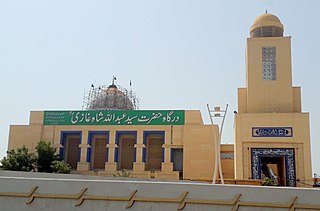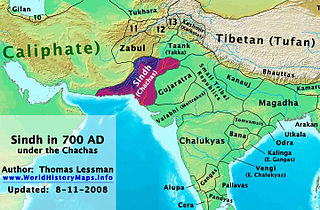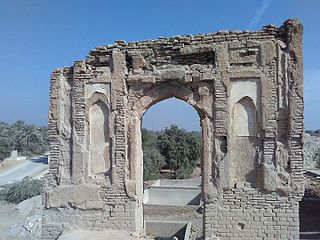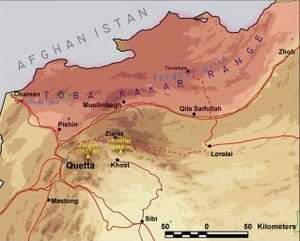
Muḥammad ibn al-Qāsim al-Thaqafī was an Arab military commander in service of the Umayyad Caliphate who led the Muslim conquest of Sindh, inaugurating the Umayyad campaigns in India. His military exploits led to the establishment of the Islamic province of Sindh, and the takeover of the region from the Sindhi Brahman dynasty and its ruler, Raja Dahir, who was subsequently decapitated with his head sent to al-Hajjaj ibn Yusuf in Basra. With the capture of the then-capital of Aror by Arab forces, Muhammad ibn al-Qasim became the first Muslim to have successfully captured Indian land, which marked the beginning of Muslim rule in South Asia.

Abu Muhammad al-Hajjaj ibn Yusuf ibn al-Hakam ibn Abi Aqil al-Thaqafi, known simply as al-Hajjaj ibn Yusuf, was the most notable governor who served the Umayyad Caliphate. He began his service under Caliph Abd al-Malik, who successively promoted him as the head of the Caliph's shurta, the governor of the Hejaz in 692–694, and the practical viceroy of a unified Iraqi province and the eastern parts of the Caliphate in 694. Al-Hajjaj retained the last post under Abd al-Malik's son and successor al-Walid I, whose decision-making was heavily influenced by al-Hajjaj, until his death in 714.
Bibi Pak Daman is a mausoleum confirmed to Pakistan Government by Imam Ali Raza Haram Research Centre Iran to be the tomb of Ruqayyah bint Ali in Lahore, Punjab, Pakistan. It holds the graves of six ladies from Muhammad's household. Ruqayyah bint Ali ibn Abu Talib was the daughter of Muhammad's cousin and son-in-law Ali ibn Abu Talib. She was the sister of Al-Abbas ibn Ali and also the wife of Muslim ibn Aqeel. Others are said to be Muslim ibn Aqil's sister and daughters. It is said that these ladies came here after the event of the Battle of Karbala on the 10th day of the month of Muharram in 61 AH.
ʿAbd al-Raḥmān ibn Abu Bakr, was an Arab Muslim military commander in the service of the Islamic prophet Muhammad, and the Rashidun caliphs Abu Bakr, and Umar. His mother was Umm Ruman and he was the full brother of Aisha.

Mir Syed Jafar Ali Khan Bahadur was a commander-in-chief or military general who reigned as the first dependent Nawab of Bengal of the British East India Company. His reign has been considered by many historians as the start of the expansion of British control of the Indian subcontinent in Indian history and a key step in the eventual British domination of vast areas of pre-partition India.

The Muslim conquests in the Indian subcontinent mainly took place between the 13th and the 18th centuries. Earlier Muslim conquests in the subcontinent include the invasions which started in the northwestern subcontinent, especially the Umayyad campaigns during the 8th century. Mahmud of Ghazni, Sultan of the Ghaznavid Empire, preserved an ideological link to the suzerainty of the Abbasid Caliphate and invaded vast parts of Punjab and Gujarat during the 11th century. After the capture of Lahore and the end of the Ghaznavids, the Ghurid ruler Muhammad of Ghor laid the foundation of Muslim rule in India in 1192. In 1202, Bakhtiyar Khalji led the Muslim conquest of Bengal, marking the easternmost expansion of Islam at the time.
Raja Dahir was the last Hindu ruler of Sindh. A Brahmin ruler, his kingdom was invaded in 711 CE by the Arab Umayyad Caliphate, led by Muhammad bin Qasim, where Dahir died while defending his kingdom. According to the Chachnama, the Umayyad campaign against Dahir was due to a pirate raid off the coast of the Sindhi coast that resulted in gifts to the Umayyad caliph from the king of Serendib being stolen.

Abdullah Shah Ghazi was a Muslim mystic and Sufi whose shrine is located in Clifton in Karachi, in Sindh province of Pakistan.

The Umayyad Dynasty came to rule the Caliphate in 661 CE, and during the first half of the 8th century CE, a series of battles took place in the Indian subcontinent between armies of the Umayyad Caliphate and Indian kingdoms situated to the east of the Indus river, subsequent to the Arab conquest of Sindh in present-day Pakistan during 711 – 713 CE.

Bukkur, Bakhar or Bhakkar is a historical city and an Island fort situated between Rohri and Sukkur in the Sindh province of Pakistan. Bhakkar is also known as "Old Sukkur".

Aror or Alor or Arorkot is the medieval name of the city of Rohri. Aror once served as the capital of Sindh.

Muhammad Qasim Nanawtawi was an Indian Sunni Hanafi Maturidi Islamic Scholar, theologian and a Sufi who was one of the main founders of the Deobandi Movement, starting from the Darul Uloom Deoband.

Mansura, referred to as Brahmanabad or Bahmanabad(Sindhi: برهمڻ آباد, romanized: barhamaṇabād, pronounced[ˈbəɾɦəmnɑːˈbɑːd̪]; ) in later centuries, was the historic capital of the caliphal province of Sindh, during the eighth century under the Umayyad Caliphate and then Abbasid Caliphate from the year 750 AD to 1006 AD. The city was founded as a central garrison by the Umayyad Forces in Sindh, the city transformed into a very vibrant metropolis during the Abbasid Era surpassing the wealth of Multan in the north and Debal in the south. Mansura was the first capital established by the Muslims in the Indian subcontinent after Muhammad bin Qasim seized the Brahmanabad territory. Mansura was built on the shores of the Indus River, it was surrounded by fertile farmland, Ibn Hauqal mentioned the wealthy local merchants who wore Baghdad Costume and were of Sindhi-Arab origins, houses were made of clay, baked bricks and plaster.
Sind was an administrative division of the Umayyad Caliphate and later of the Abbasid Caliphate in post-classical India, from around 711 CE with the Umayyad conquest of Sindh by the Arab military commander Muhammad ibn al-Qasim, to around 854 CE with the emergence of the independent dynasties of the Habbarid Emirate and the Emirate of Multan. The "Governor of Sind" was an official who administered the caliphal province over what are now Sindh and South Punjab in Pakistan, with Makran in Balochistan also usually being under his control.

The Brahmin dynasty of Sindh, also known as the Chacha dynasty, was the ruling dynasty of the Sindh, succeeding the Rai dynasty. Most of the information about its existence comes from the Chach Nama, a historical account of the Chach-Brahmin dynasty.

The Arab conquest of Kaikan was a military campaign by the Rashidun and Umayyad Caliphates aganist the Jats of Kaikan, in present-day Pakistan. The Kingdom of Kaikan faced several invasions from the caliphate. During the reign of the Khalifa Al-Mutasim, the Arabs annexed this region successfully after defeating the Jats.

The Umayyad conquest of Sindh took place in 711 AD against the ruling Brahmin dynasty of Sindh and resulted in Sindh being incorporated as a province into the Umayyad Caliphate. The conquest resulted in the overthrow of the last Hindu dynasty of Sindh, the Brahman dynasty, after the death of Raja Dahir.
Surya Devi, was an Indian Hindu Princess of Sind. She is known for having been the war booty of the Umayyad army commander Muhammad bin Qasim during the Umayyad conquest of Sindh and given along with her sister as slaves to Caliph Sulayman ibn Abd al-Malik. According to the traditional story, she persuaded the Caliph to execute Muhammad bin Qasim, avenging her parents, and then managed to escape the captivity of the harem by having the Caliph execute her and her sister.

The Battle of Aror took place in 711 AD between the Umayyad forces under Muhammad ibn al-Qasim and the army of Brahmin dynasty of Sindh under Raja Dahir. It was the last military conflict of Raja Dahir, in which the Umayyads defeated his army near The Indus River and resulted in the death of Dahir.
Sehwan Fort, known locally as Ulti Basti, is a ruined fort situated in Sehwan, Sindh, Pakistan.













